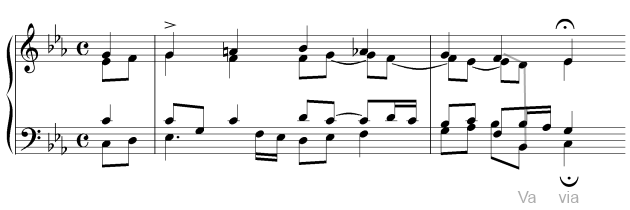Music Theory Audio Examples

If you are like many other music theory students, you might find it difficult to “hear” in your head when you’re reading about music theory.
It’s quite a skill to be able to hear music from the written page, especially when chords, awkward intervals or more than one instrument is involved.
Like any skill, practice makes perfect however!
There are plenty of websites specifically aimed at training your ear; we recommend easyeartraining.com. With a little daily practice, you can achieve amazing aural results. On this page you will find audio examples of music theory concepts such as cadences, progressions and melodic decoration for you to listen to.
These audio examples will help you to “hear” in your head common points of music theory – from real life pieces of music.
I’ve picked compositions from the three main musical eras which conform to the rules of music theory, to help illustrate how each technique developed over time, where possible:
Baroque (1600-1700), Classical (1700-1800) and Romantic (1800-1900)*
Please let me know if there is something you’d like me to add this page!
Please note that the audio recordings on this page have sometimes been played at a slower tempo than the composer indicated. This is simply to make it easier to hear what is happening! Listen carefully and follow the score as you are listening!
- Anticipation
- Auxiliary note – chromatic
- Auxiliary note – diatonic
- Diminished 7th
- French 6th
- German 6th
- Interrupted cadence
- Italian 6th
- Melodic sequence
- Neapolitan 6th
- Passing note – accented
- Passing note – unaccented
- Pedal – inner
- Pedal – sustained
- Pedal – unsustained
- Perfect cadence
- Retardation
- Plagal cadence
- Secondary dominant
- Suspension
- Tierce de Picardie
- Tritone substitution
- Whole tone scale
French 6th
The French 6th works like chord II. Because of this, it is usually followed by chord V (following the progression of 5ths).
In the key of G minor, chord ii° is diminished: A-C-Eb. In G major it is minor: A-C-E. In a French 6th chord, the 3rd is always major above the root (=C#), and the 5th is always diminished above the root (=Eb). In addition, the 7th of the chord (G) is added.
The chord is therefore the same in both the major and minor versions of a key. In G, it is A-C#-Eb-G. French 6ths are used in 2nd inversion. This creates an augmented interval between the bass and a higher note (Eb-C# is an augmented 6th, which is where the name “6th” comes from). The bass has a strong urge to resolve by a semitone step down to D, the dominant note.
Romantic: Beethoven Sonata no.19 in G minor. The French 6th is normally followed by a dominant chord. The bass falls by a semitone (Eb-D).

German 6th
The German 6th is another II substitute chord (like the French 6th). II chords have strong tendency to resolve to V.
Built on the 2nd degree of the scale, the 3rd is major above the root and the 5th is diminished, and the 7th is added: in G minor this produces A-C#-Eb-G (which is a French 6th). A ninth is then added (Bb), the root (A) is omitted, and the chord is used in the 2nd inversion. The end result is Eb-G-Bb-C#. Like the French 6th, it is called a “6th” chord because there is an augmented 6th between the bass (Eb) and C#.
The German 6th is enharmonically the same as the 7th chord built on the flattened 6th degree of the scale. E.g. in G minor, the 6th is Eb. The 7th chord is Eb-G-Bb-Db. The German 6th is “spelled” differently (C# instead of Db) and functions differently. A German 6th resolves to V, whereas a VI7 would function as a dominant 7th leading to a tonic Ab major chord (modulation). The C# is a leading note, which resolves to the tonic D. Db is does not have a leading note function in the chord.
Romantic: Rachmaninov Sonata in G minor, Op.23. The resolution of the German 6th to V is delayed by a diminished 7th chord, but the Eb bass ultimately resolves downwards to D.

Interrupted Cadence
Baroque: Bach Chorale no.196. An interrupted cadence is the chord progression V-VI. It is quite rare to find this cadence in Bach’s work, where the perfect cadence is by far the most common. The key is Eb major.

Melodic Sequence
Baroque: Bach Prelude no.20 (Book 1, 48 Preludes and Fugues). The opening motif is sequenced in the following bars, with some minor alterations.

Classical: Mozart Piano Sonata no.11, 3rd Movement. The opening motif is sequenced using the ascending notes of the tonic triad (A minor) as a start note in each case.

Romantic: Schumann “Mai, lieber Mai”, for Piano. The second sequence starts one scale-step higher and has some minor alterations.

Neapolitan 6th
The Neapolitan 6th is the major chord formed on the flattened supertonic. It’s most commonly found in minor keys, so in D minor (for example), you first find the supertonic (E), then flatten it by a semitone (Eb), then create the major triad from that root (Eb-G-Bb). The chord is very often, but not exclusively, found in first inversion and is usually followed by the dominant chord. Here, Beethoven uses it in root position.
The key is D minor. The first box shows the Neapolitan 6th chord, Eb major, the second box shows the dominant A major chord.

(The audio here is at a slower tempo, to help you focus on the harmony.)
Perfect Cadence
Baroque: Bach Chorale no.57. The V chord (E major) is marked with a grey line. The alto D is an unaccented passing note on the 7th of the chord. Bach would not have placed the 7th on an accented beat, because this interval (a 7th) was classed as a dissonance.

Classical: Mozart Piano Sonata no.5, 3rd Movement. The piece has modulated from G major to D major. The perfect cadence is in the new key.

Romantic: Chopin Valse Op.64 no.2 in C# minor. By this time, using an unprepared V7 chord was commonplace.

Passing Note – Accented
Baroque: Bach Chorale no.252. The accented passing notes are circled, the key is Bb major.

Pedal – Inner
A pedal is a repeated or sustained note, usually the tonic or dominant, which is played continously throughout a series of chords. Because the chords change, the pedal note will be consonant with some and dissonant with others. Pedals are most often found in the bass line of a piece. When they occur between the bass line and melody line they are called “inner” pedals.
This inner pedal is found in “Das Wandern”, a song by Schubert (Romantic era). (The original is for tenor voice; the oboe in this MIDI file is playing an octave higher than a tenor would be singing.)
The first box shows an inner pedal on D – the dominant note in the key of G minor. The piece then changes to key to F major, and the inner pedal is the dominant C.

Plagal Cadence
Baroque: Bach Chorale no. 12. The plagal cadence (IV-I) is rarely used to end a piece. It is occasionally found within a piece, or used at the end after a perfect cadence as an “Amen” cadence in sacred music.

Secondary Dominant
Baroque: Bach chorale no. 248. The key is G major. The circled C# creates an A major chord, which is the dominant of D major, making a secondary dominant chord. The D major chord is a pivot chord, taking the piece back to G major with a perfect cadence.

Suspension
Baroque: Bach Prelude no.12 (Book 1, 48 Preludes and Fugues). The circled notes are suspensions.

Classical: Mozart Piano Sonata no.14, 3rd Movement. The suspended notes are circled.

Tierce de Picardie
Baroque: Bach Chorale no.31. The chorale is in A minor, but ends with an A major chord, with a sharpened 3rd.

Whole Tone Scale
The whole tone scale is built of whole steps, or tones. Starting on C and moving up only by tones, you would produce the scale C-D-E-F#-G#-A#. It has a dreamy effect, since none of the notes is audibly a “key note” or tonic equivalent. The most famous composer who experimented with this scale was Claude Debussy. Here are a couple of bars from his piano piece “Reflets dans l’Eau”, using the whole tone scale F-G-A-B/Cb- Db-Eb.

* These dates are rough guidelines – the musical eras overlapped considerably, but is useful to group them by century.